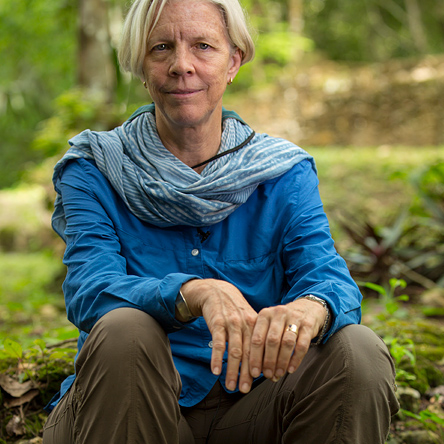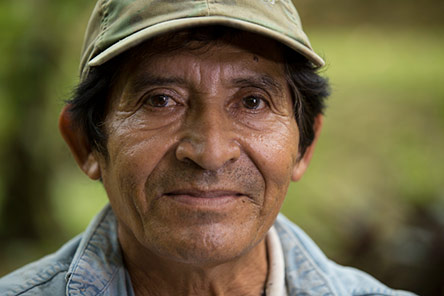A Life’s Work

Indiana Jones has nothing on Anabel Ford. The daughter of a Hollywood actress and a world-renowned sociologist, Ford is the archaeological powerhouse who in 1983 rediscovered the ancient Maya city of El Pilar.
Once home to a thriving population of more than 20,000 people, El Pilar straddles the present-day border of Belize and Guatemala. Lying beneath the lush canopy of the Maya forest, the city reached its zenith around 700 A.D. It is now protected as El Pilar Archaeological Reserve for Maya Flora and Fauna, encompassing 5,000 acres and an ancient Maya center that includes 150 acres of temples, plazas and palaces.
Ford, who has been working in the Maya forest since 1972, came across the city site of El Pilar while doing survey work in the region. She spent the next three decades mapping, excavating and studying the site and its surroundings, and has made El Pilar a unique model of binational cooperation, community empowerment, conservation and preservation.
That Ford would gravitate toward this field of study comes as no surprise. She was an experienced world traveler by junior high school, having considered herself at home throughout Europe and the Middle East — Rome at age 4, Vienna at 6, Madrid at 10 and Beirut at 14. “To me, being an archaeologist is studying the common human experience in different environments in different times,” she says. “I’ve traveled enough to know there are common threads, common stories.”
A documentary film highlighting Ford’s decades-long work at the ancient city site and surrounding forest, “El Pilar: Preserving the Maya Legacy,” premiered Oct. 1, at the Catalina Film Festival. The film, which received the Award of Excellence in the conservation category, can be viewed online at https://vimeo.com/163885061/cebab0ccef
The Forest Garden
The ancient Maya have long been exalted for their architectural and artistic grandeur, but they also were superb gardeners who domesticated their wild jungles and tropical landscape and established their cities based on forest gardens.
And yet, for decades, the Maya — and their descendants — have gotten a bad rap from archaeologists, anthropologists, and other scholars who cite the ancient civilization’s agricultural practices for its eventual collapse. While they agree that other factors contributed to the fall of Maya society roughly 1,000 years ago, they claim the civilization’s slash-and-burn approach to farming caused such widespread environmental devastation that the land simply could not sustain them.
But Ford’s long-term research suggests an alternative — the forest gardens encountered by the Spanish and cultivated by the Maya today demonstrate their great appreciation for the environment.
The Maya, who farmed without draft animals or plows, used stone tools and fire to follow what Ford calls the “milpa cycle.” It is an ancient land use system by which a closed canopy forest is transformed into an open field for annual crops, then a managed orchard garden, and then a closed canopy forest once again. The cycle covers a time period of 12 to 24 years.
A misconception about the milpa cycle is that the fields lie fallow after several years of annual crop cultivation. “In reality, in the ‘high-performance milpa,’ fields are never abandoned, even when they are forested,” Ford explained. “The milpa cycle is a rotation of annuals with successive stages of forest perennials during which all phases receive careful human management.

Narciso Torres, one of the last remaining Maya Forest Gardeners
“As a cultivated field,” Ford continued, “the milpa has its own ecology of herbs, tubers and plants that deter pests of the main crops, enhance soil nutrients and maintain moisture in the soil. Even before this phase of annual crops is over, the selection of trees and bushes for the woodland stages begins, resource stocking for the future.”
Tailoring their efforts to the local geography, the Maya cultivated the forest as a garden for thousands of years. These forest gardens — unplowed, tree-dominated plots managed in a way that support biodiversity and animal habitat — sustained them by providing food, spices and medicines.
That alliance with nature continues today as master forest gardeners such as Narcisso Torres and Alfonso Tzul, Ford’s friends and mentors, cultivate and nurture the same precious flora that sustained their ancestors.
Logging and Looting: Threats to El Pilar
El Pilar’s status as a binational cultural reserve does not protect it from those who would take advantage of the forest’s treasures. On a seemingly regular basis, Ford comes up against the evidence of loggers who illegally strip the forest of prized hardwood trees such as mahogany and cedar.
“We’ve seen logs recently cut, we even see them being hauled out — 500 meters right inside the reserve, right off the road,” she said. “It’s appalling that someone thinks they can do that.”
On one such occasion, as Ford drove along the rough and rutted unpaved road that leads in and out of El Pilar, she was flagged down by the reserve’s caretaker, David Landero, machete in hand. Bad news: Sometime during the previous night loggers had cut down a great mahogany tree. They had left it where it landed planning to return the following day to chop it into more manageable pieces and haul it out.
Ford and her team hiked up the hill to investigate, and as they soon discovered, much to their dismay, the tree the caretaker had seen was one of five that particular group of loggers had felled.